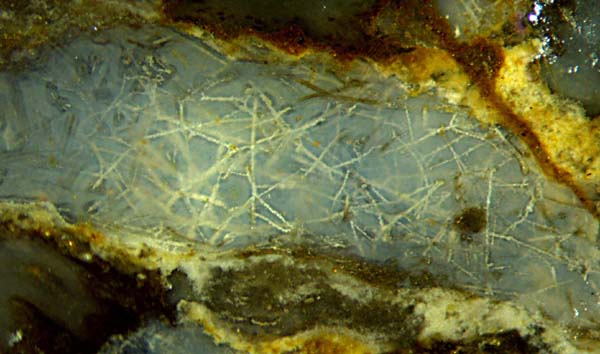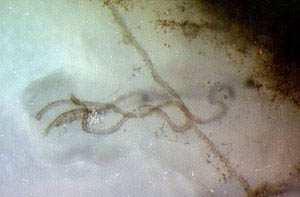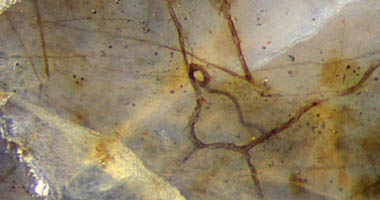The enigma of perfectly straight fungus hyphae
Fungus
hyphae are abundantly found in the Lower Devonian chert from Rhynie, which is famous for fossil land plants.
Probably the hyphae represent several fungus species, judging from the
variety of apparences. The
below pictures have been specially selected for uncommon
details. Often the hyphae
form confusing tangles or frameworks whose components are more or less
straight, eventually of differing thickness (Fig.1). Less
often they are distinctly curved as in Figs.2,3.



Figs. 1-3: Fungus hyphae of different aspect in
Rhynie chert. Width of the frames 2.5mm, 1mm,
2.5mm.
Fig.4: Conspicuously straight
fungus hyphae coated
with chalzedony and quartz topping. Width 5.5mm.
These
fungi throve in water, hence they have to be distinguished from those
which grew within plant matter, dead or alive, also preserved in the Rhynie chert.
The
water including the hyphae may have turned into silica gel and later
into chalcedony as a whole. Apparently with lower supersaturation of
the silica solution, the hyphae became coated, with water left in
between. Eventually the supersaturation was so low that quartz
crystals instead of chalzedony grew on the outside of the coatings.
Obviously, silica deposition stopped permanently for some reason at some time so
that a cavity was left, which is still there now, with coated hyphae
suspended between the walls, as in Fig.4.
Cavities
crossed with coated hyphae are not abundant, and what is seen in Fig.4
is the realisation of an unbelievably small chance. Unawares of the
presence of such cavity in the chert sample, the cut incidentally has gone right along an unusually long straight coated
hypha. Furthermore, the cut plane is so close to the
hypha that part of the quartz coating has been cut away and the
hypha is dimly seen through. Visual inspection reveals a straight hypha with a length of more than 300
times
its diameter. How could
the fungus possibly have kept to the once chosen
direction with such accuracy, and
for what purpose ? Judging from the hyphae seen running in any
direction, there is no pre-set favourite direction which could have
served as guidance.
The idea that
the cavity with hyphae might have been stretched horizontally while the
whole
was still soft must be excluded because, incidentally
again, there is another straight hypha seen in Fig.4: It is on the left
half of the picture, shorter than and running across the horizontal
one.
As
a possible explanation, the hypha could have stuck to two fixed
points, then contracted, thus pulling itself straight. It has to be
found out whether or not this is compatible with hypha frameworks as
in Fig.1.
H.-J.
Weiss
2015
 |
 |
78 |







